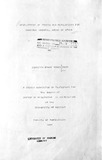| dc.description.abstract | Two population improvement methods. Stratified Mass Selection (SMS) and Mass Selection with Progeny Testing (MSPT) were used in the improvement of grain yields of pigeon pea composite populations under marginal rainfall conditions of Kenya. Selection pressures of ten and five per cent were used under SMS and MSPT respectively.
Four improved populations under SMS and two under MSPT together with the original population were tested In replicated yield trials at three locations for two years.
Mean responses of 2.3 and 4,3 per cent per cycle of selection were realised under SMS and MSPT, respective ly. There was no response to selection when improved populations
were tested in a wet growing season. However, when measured in a drier growing season, the progress per cycle of selection was 6.7 and 6.0 per cent for SMS and MSPT, respect ively.
A number of plant characters had positive and others negative relationships with grain yield. Those with positive correlations
with grain yield were number of pods per plant, number of seeds per plant, 100-seed weight, plant height, canopy width and number of primary branches. Plant characters which had negative correlations with grain yield were number of seeds per pod, crude protein content of whole grain, leaf area of single leaf and dry matter in pods. SNS and MSPT methods altered character associations in the improved populations; some positively and others negatively.
Several drought resist anee indices were measured in improved and original populations. These drought resistance indices were tap-root length and number of lateral roots in seedlings and adult plants, transpiration rates, chlorophyll stability index and seed germination and growth rates in various moisture tensions. Although none of these drought resistance characters were selected for, they were all better developed in the selected populations than in the original population. This indicates that by selecting for high yielding plants under marginal rainfall conditions, drought resistant
plants are also selected simultaneously.
I
Genotype-envi rorvnent interaction of grain yield was calculated. Although there was no genotype-environment interaction, environments - both locations within one season, and growing seasons within one location - were very highly significantly different.
Degree of outcrossing was measured in six locations in Kenya. Outcrossing varied between 25.2 and 94.5 per cent. The major factors which influenced outcrossing were availability and activity of insect pollinators. Insect pollinators foraging on pigeon pea flowers were caught at four sites in Kenya. These comprised six genera and 24 species, of which ChctZicodomci < Megachile and Xylooopa species were most predominant.
Since maintaining genetic purity of pure line pigeon pea cultivars is difficult because of contamination by open pollination as soon as thoy are grown in farmers’ fields, development of population cultivars with broad genetic base, which will also be more stable under erratic environments such as are found in marginal rain fall areas of Kenya, are recommended for this
crop. | |

